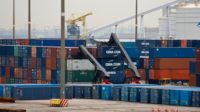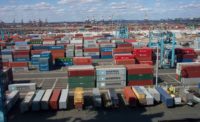The new agreement on U.S. imports of steel from the European Union will take effect on Jan. 1, after President Joe Biden issued a proclamation making the adjustments reached by negotiators during the G20 summit in October.
The deal sets a quarterly tariff-rate quota, so the first 3.3 million metric tons of steel won’t be subject to a tariff, and any steel beyond that will be subject to a 25% duty. The new arrangement lasts through 2023.
U.S. steel industry groups such as the Steel Manufacturers Association and American Iron and Steel Institute have welcomed the deal, although they share concerns about some details and implementation.
“We understand that in any negotiation, there has to be some give and take,” says Philip Bell, manufacturers' group president. “We’re very pleased to see that there’s a ‘melted and poured’ requirement in the agreement that’s going to help ensure that steel that is tariff free is melted and poured in the EU. On the flip side of that, we were somewhat disappointed that exclusions were grandfathered for two years.”
U.S. importers still will be able to apply for duty exclusions for steel products from the EU that are not produced in the U.S., as had been allowed under Trump administration tariffs set in 2018. The deal renews exclusions granted in 2021 for the next two years. However, Biden, after taking comments from industry groups and unions, directed the US Commerce Dept. to propose new regulations within the next few months to revise the exclusion process.
Biden’s proclamation specifies that only steel melted and poured in the EU will be eligible for inclusion under the quota, meaning that steel produced in China and sent to Europe for finishing will still be subject to the tariff.
“In my judgment, these measures will provide an effective, long-term alternative means to address any contribution by EU steel articles imports to the threatened impairment of the national security by restraining steel articles imports to the U.S. from the EU, limiting transshipment, discouraging excess steel capacity and production, and strengthening the U.S.-EU partnership in a fashion that will better enable future arrangements,” Biden said in the proclamation.
Kevin Dempsey, steel institute president and CEO, said the group was “particularly gratified” by the emphasis on only including steel originating in the EU under the quota, but he and Bell both noted that proper implementation and enforcement will be crucial in preventing a surge of steel imports.
Officials on both sides of the deal have set a deadline of Oct. 31, 2023, to negotiate a new arrangement that will support reducing the carbon intensity of steel and aluminum production in addition to restoring market-oriented conditions.
“The American steel industry is the cleanest and most energy efficient of the leading steel industries in the world, and we have achieved these results through market-driven competition and without reliance on market-distorting government subsidies,” Dempsey said in a statement. “This is a model we urge other nations to adopt as we work together to provide solutions to the global climate crisis and to eliminate global excess capacity in steel.”
The Commerce Dept. also has been working on steel agreements with the U.K. and Japan. Bell says it’s important to treat each country individually.
“This shouldn’t be a template for other deals because the situations in other countries are not the same as they are in the EU,” he says. “For example, Japan struggles with producing low-carbon-intensity steel, and there’s no reason why they can get more than they deserve as we continue our negotiations with them.”






Post a comment to this article
Report Abusive Comment